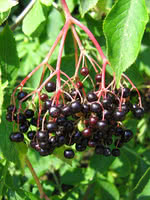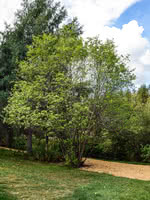Mon-Fri 9am - 5pm Mountain time
Grey Alder vs Black Elderberry
Sambucus canadensis
Alnus incana
NOT AVAILABLE THIS SEASON - MIGHT RETURN
NOT AVAILABLE THIS SEASON - MIGHT RETURN
Black Elderberry is a deciduous shrub native to eastern North America. You can plant this shrub in moist areas and it will help stabilize your soil. You can also use it on rural properties anywhere you'd use a lilac.
Black Elderberries are considered to be partially self-pollinating. So while they will still produce some berries without cross-pollination, planting with another variety will increase yields. Consider planting with Ranch Elderberry or Bob Gordon Elderberry.
Warning: the seeds, stems, leaves, roots, and uncooked berries of the Black Elderberry are poisonous to humans when eaten in quantity. You should cook the berries to make them safe for human consumption.
River Alder is a large shrub or small tree with a multi-stemmed, spreading habit. It is an excellent tree to plant if you want to stabilize the soil near rivers and creeks.
Unlike the other alder varieties, River Alder is attractive enough to be included in riverside plantings by municipal and provincial park organizations.
Note: We use Grey Alder for Alnus incana. This species is also known by many other common names, including River Alder, Speckled Alder, and others. Please confirm the scientific name to ensure you are ordering the correct plant.
Black Elderberry Quick Facts
Grey Alder Quick Facts
Toxicity: leaves, stems, and uncooked berries are poisonous to humans

